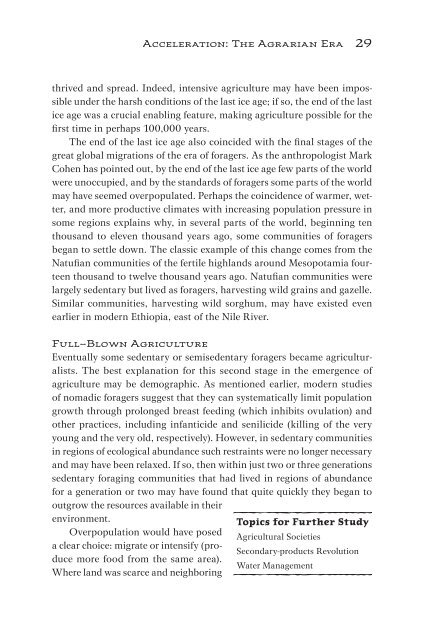This Fleeting World
This Fleeting World
This Fleeting World
Create successful ePaper yourself
Turn your PDF publications into a flip-book with our unique Google optimized e-Paper software.
Acceleration: The Agrarian Era 29<br />
thrived and spread. Indeed, intensive agriculture may have been impossible<br />
under the harsh conditions of the last ice age; if so, the end of the last<br />
ice age was a crucial enabling feature, making agriculture possible for the<br />
first time in perhaps 100,000 years.<br />
The end of the last ice age also coincided with the final stages of the<br />
great global migrations of the era of foragers. As the anthropologist Mark<br />
Cohen has pointed out, by the end of the last ice age few parts of the world<br />
were unoccupied, and by the standards of foragers some parts of the world<br />
may have seemed overpopulated. Perhaps the coincidence of warmer, wetter,<br />
and more productive climates with increasing population pressure in<br />
some regions explains why, in several parts of the world, beginning ten<br />
thousand to eleven thousand years ago, some communities of foragers<br />
began to settle down. The classic example of this change comes from the<br />
Natufian communities of the fertile highlands around Mesopotamia fourteen<br />
thousand to twelve thousand years ago. Natufian communities were<br />
largely sedentary but lived as foragers, harvesting wild grains and gazelle.<br />
Similar communities, harvesting wild sorghum, may have existed even<br />
earlier in modern Ethiopia, east of the Nile River.<br />
Full-Blown Agriculture<br />
Eventually some sedentary or semisedentary foragers became agriculturalists.<br />
The best explanation for this second stage in the emergence of<br />
agriculture may be demographic. As mentioned earlier, modern studies<br />
of nomadic foragers suggest that they can systematically limit population<br />
growth through prolonged breast feeding (which inhibits ovulation) and<br />
other practices, including infanticide and senilicide (killing of the very<br />
young and the very old, respectively). However, in sedentary communities<br />
in regions of ecological abundance such restraints were no longer necessary<br />
and may have been relaxed. If so, then within just two or three generations<br />
sedentary foraging communities that had lived in regions of abundance<br />
for a generation or two may have found that quite quickly they began to<br />
outgrow the resources available in their<br />
environment.<br />
Topics for Further Study<br />
Overpopulation would have posed<br />
Agricultural Societies<br />
a clear choice: migrate or intensify (produce<br />
more food from the same area).<br />
Secondary-products Revolution<br />
Water Management<br />
Where land was scarce and neighboring


